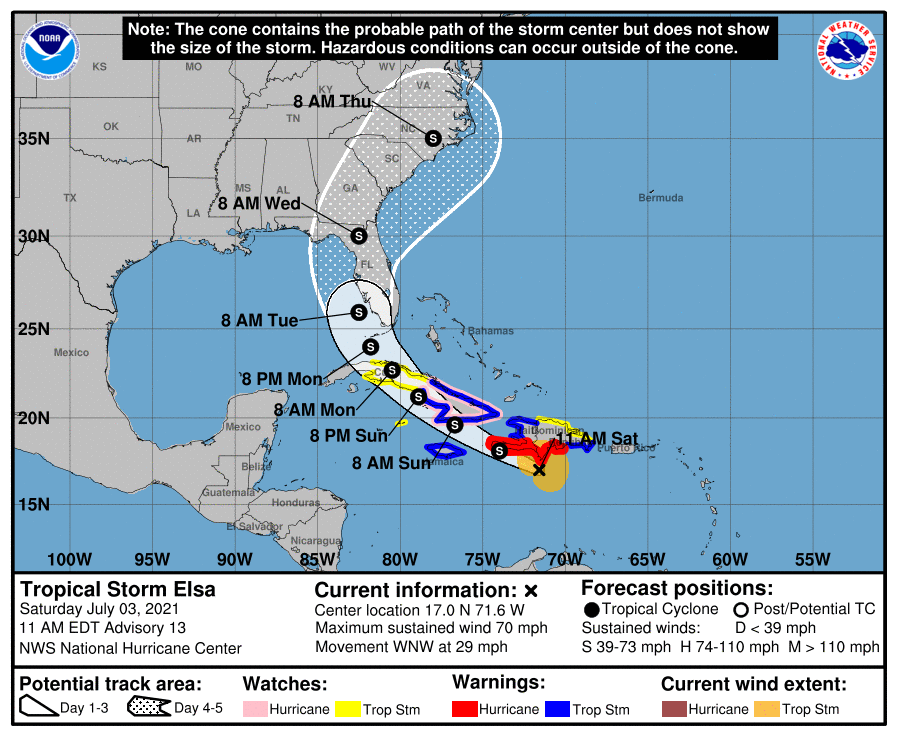|
|
NHC15Z降格TS,預測可能於一天內登陸多米尼加
000
WTNT45 KNHC 031501
TCDAT5
Tropical Storm Elsa Discussion Number 13
NWS National Hurricane Center Miami FL AL052021
1100 AM EDT Sat Jul 03 2021
Reports from an Air Force Reserve Hurricane Hunter aircraft and
satellite imagery indicate that Elsa has weakened some since the
last advisory. The aircraft reported maximum 700-mb flight-level
winds of 64 kt well to the northeast of the center, and maximum
surface winds estimates from the SFMR of about 55 kt. The
aircraft-reported central pressure is near 999 mb and gradually
rising, In addition, the center was exposed for a few hours,
although it is now located at the northwestern edge of a new
convective burst. Based on the aircraft data, the initial intensity
is reduced to 60 kt.
The initial motion is now 295/25. Elsa is approaching a weakness in
the subtropical ridge caused by a large baroclinic trough over the
eastern United States. The global models forecast this trough to
move eastward into the Atlantic, but the southern portion is likely
to split off and become an upper-level low pressure area over the
western Gulf of Mexico, with the subtropical ridge over the Atlantic
situated to the east of the this low. This evolution should cause
Elsa to slow its current breakneck forward speed during the next day
or so, then turn northwestward between 36-60 h, followed by a
general northward motion from 72-96 h and recurvature into the
westerlies after that time. The track guidance is in much better
agreement than this time yesterday, and Elsa is expected to pass
near or over southwestern Haiti, Cuba, and the eastern Gulf of
Mexico or the Florida Peninsula during the next 3 days or so. After
that, the system is likely to cross portions of the southeastern
United States on its way into the Atlantic. The new NHC forecast
track has only minor adjustments from the previous one, and it lies
near the various consensus models.
Elsa continues to be affected by northwesterly shear that is at
least partly due to the fast forward motion. While the forward
speed is forecast to decrease over the next few days, continued
westerly shear and land interaction are expected to cause additional
weakening. Indeed, by 60 h, the GFS, UKMET, and ECMWF show Elsa as
a weak system with some separation between the low- and mid-level
centers. While some shear is likely to continue when the storm is
near or over the eastern Gulf of Mexico, upper-level divergence
associated with the aforementioned upper-level low could allow for
some re-intensification. The new NHC intensity forecast calls for
more weakening in the first 48 h than previously forecast and then
shows re-intensification over the Gulf of Mexico. Through the first
72 h, the forecast is at the upper edge of the intensity guidance.
Although Elsa is now a tropical storm, hurricane warnings remain in
effect for portions of the Dominican Republic and Haiti at this
time, as conditions have not yet reached their worst there and the
possibility that a short-lived re-intensification might occur due
to a convective burst.
Given that there is still uncertainty in the track forecast and the
degree of land interaction with Hispaniola and Cuba, users are
urged to factor in some of this uncertainty. For reference, average
NHC track errors at days 3 and 4 are 125 miles and 150 miles,
respectively. The average NHC intensity errors are around 15 mph
for both days 3 and 4.
Key Messages:
1. A hurricane warning remains in effect for portions of Haiti and
the Dominican Republic, where near-hurricane conditions and
dangerous storm surge are expected through this evening.
2. Widespread heavy rain will move across southern Hispaniola and
Jamaica today into Sunday where isolated to scattered flash flooding
and mudslides will be possible. Heavy rain will impact the Cayman
Islands and Cuba Sunday into Monday, resulting in significant
flooding and mudslides over Cuba. As Elsa approaches the Florida
Keys and southern Florida early next week, isolated flash flooding
and minor river flooding will be possible.
3. Tropical storm conditions and dangerous storm surge are expected
with hurricane conditions possible in portions of eastern Cuba
beginning early Sunday, with tropical storm conditions possible in
central Cuba Sunday night and Monday.
4. There is an increasing risk of tropical storm conditions, storm
surge, and rainfall impacts beginning Monday in the Florida Keys and
the southern Florida Peninsula. This risk will spread northward
along the Florida Peninsula through Wednesday and reach the coasts
of Georgia and the Carolinas Wednesday and Thursday, however
uncertainty in the forecast remains larger than usual due to Elsa's
potential interaction with the islands of Hispaniola and Cuba.
Interests in Florida and along the southeast U.S. coast should
monitor Elsa's progress and updates to the forecast.
FORECAST POSITIONS AND MAX WINDS
INIT 03/1500Z 17.0N 71.6W 60 KT 70 MPH
12H 04/0000Z 18.1N 74.0W 60 KT 70 MPH
24H 04/1200Z 19.6N 76.7W 60 KT 70 MPH
36H 05/0000Z 21.2N 78.9W 55 KT 65 MPH
48H 05/1200Z 22.7N 80.5W 45 KT 50 MPH...INLAND
60H 06/0000Z 24.0N 81.8W 50 KT 60 MPH...OVER WATER
72H 06/1200Z 25.9N 82.5W 55 KT 65 MPH
96H 07/1200Z 30.0N 82.5W 50 KT 60 MPH...INLAND
120H 08/1200Z 35.0N 78.0W 35 KT 40 MPH...INLAND
$$
Forecaster Beven 
|
|